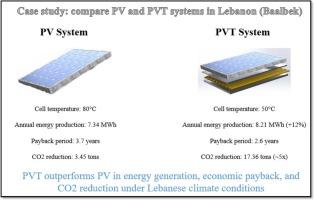Performance, economic, and environmental assessment of PV and PVT systems in Lebanon: A comparative case study
IF 7.6
Q1 ENERGY & FUELS
引用次数: 0
Abstract
In areas with great solar potential, like Lebanon, combining solar energy systems—especially photovoltaic (PV) and photovoltaic-thermal (PVT) technologies—has emerged as a viable answer to growing energy demands and environmental issues. Through a real-world investigation in Lebanon, this study compares the electrical performance, economic feasibility, and environmental impact of standalone PV and hybrid PVT systems. A validated simulation approach, a thorough economic and CO2 mitigation analysis, and localized thermal modeling and monthly performance comparison of PV and PVT systems under Lebanese climate circumstances are what make this work unique. Electrical energy output and efficiency were estimated using thermal models for both systems. The models were checked against the body of existing research. Over the course of a year, analysis was done on monthly energy output, system efficiencies, payback periods, and CO2 emissions reductions. In January, PV and PVT systems generated 372.5 kWh and 391.7 kWh of electricity, respectively, while in July, they generated 796.3 kWh and 934.2 kWh. During hot months, the PVT system’s electrical efficiency advantage over PV peaked at 17.3 %, with a minimum difference of 5.2 % during the winter. In terms of economics, the PV system’s payback period was 3.7 years, while the PVT system’s was 1.1 years. In terms of the environment, PV and PVT reduced CO2 emissions by 3.45 and 17.36 tons annually, respectively.

黎巴嫩PV和PVT系统的性能、经济和环境评估:一个比较案例研究
在太阳能潜力巨大的地区,如黎巴嫩,结合太阳能系统,特别是光伏(PV)和光电热(PVT)技术,已成为解决日益增长的能源需求和环境问题的可行办法。通过在黎巴嫩的实际调查,本研究比较了独立PV和混合PV系统的电气性能、经济可行性和环境影响。经过验证的模拟方法、全面的经济和二氧化碳减排分析、黎巴嫩气候条件下PV和PVT系统的局部热建模和月度性能比较使这项工作与众不同。利用热模型对两个系统的电能输出和效率进行了估计。这些模型是根据现有研究的主体进行检验的。在一年的时间里,对每月的能源输出、系统效率、投资回收期和二氧化碳减排进行了分析。1月份,光伏和PVT系统的发电量分别为372.5千瓦时和391.7千瓦时,而7月份的发电量分别为796.3千瓦时和934.2千瓦时。在炎热的月份,PVT系统比PV的电效率优势达到17.3%的峰值,在冬季的最低差异为5.2%。在经济性方面,光伏系统的投资回收期为3.7年,而PVT系统的投资回收期为1.1年。在环境方面,PV和PVT每年分别减少3.45吨和17.36吨的二氧化碳排放。
本文章由计算机程序翻译,如有差异,请以英文原文为准。
求助全文
约1分钟内获得全文
求助全文
来源期刊

Energy Conversion and Management-X
Multiple-
CiteScore
8.80
自引率
3.20%
发文量
180
审稿时长
58 days
期刊介绍:
Energy Conversion and Management: X is the open access extension of the reputable journal Energy Conversion and Management, serving as a platform for interdisciplinary research on a wide array of critical energy subjects. The journal is dedicated to publishing original contributions and in-depth technical review articles that present groundbreaking research on topics spanning energy generation, utilization, conversion, storage, transmission, conservation, management, and sustainability.
The scope of Energy Conversion and Management: X encompasses various forms of energy, including mechanical, thermal, nuclear, chemical, electromagnetic, magnetic, and electric energy. It addresses all known energy resources, highlighting both conventional sources like fossil fuels and nuclear power, as well as renewable resources such as solar, biomass, hydro, wind, geothermal, and ocean energy.
 求助内容:
求助内容: 应助结果提醒方式:
应助结果提醒方式:


